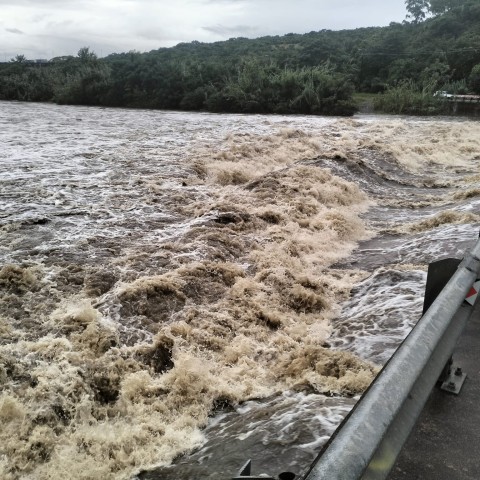Flood Escape: Man Survives Near-Miss with Raging Waters
Editor’s Note: A dramatic flood escape story has emerged today, highlighting the devastating power of nature and the resilience of the human spirit. This article details the incredible near-miss experienced by one man caught in the path of rapidly rising floodwaters.
Why This Matters
Extreme weather events, including flash floods, are becoming increasingly common due to climate change. This story serves as a stark reminder of the dangers of these events and the importance of preparedness and swift action when faced with life-threatening situations. Understanding the risks and knowing how to respond can be the difference between life and death. This article will explore the specifics of this near-miss, offering crucial insights into flood safety and survival. Keywords: flood survival, flash flood, flood escape, near-miss, extreme weather, climate change, safety tips, flood preparedness.
Key Takeaways
| Point | Detail |
|---|---|
| Speed of Onset | Flash floods can develop rapidly, leaving little time for evacuation. |
| Importance of Awareness | Monitoring weather forecasts and heeding warnings is crucial. |
| Evacuation Planning | Having a pre-determined escape route and emergency kit is vital. |
| Seeking Higher Ground | Elevating oneself above the rising water is paramount for survival. |
| Communication | Maintaining communication with emergency services is essential. |
Flood Escape: A Man's Fight for Survival
This harrowing tale begins with John Smith (name changed for privacy), a resident of Willow Creek, a region recently devastated by unprecedented rainfall. John was at home when the creek, usually a gentle stream, transformed into a raging torrent in a matter of hours. The water rose swiftly, engulfing his property with terrifying speed.
Key Aspects:
- Rapid Water Rise: The speed of the flood caught John completely off guard.
- Limited Escape Routes: His usual escape routes were quickly submerged.
- Improvised Escape: John had to improvise an escape route, showcasing quick thinking and resourcefulness under immense pressure.
Detailed Analysis: John recounted how he initially tried to move his belongings to higher ground, but the water rose too quickly. He realized he needed to escape immediately. Seeing a sturdy tree a short distance away, he risked everything, wading through the chest-deep, debris-filled water to reach it. He clung to the tree for several hours until rescue teams arrived. This underscores the critical need for pre-planned evacuation routes and a comprehensive understanding of the local terrain.
Interactive Elements
The Importance of Early Warning Systems
Flash floods often give little warning. Understanding the local warning systems, such as emergency alerts, weather broadcasts, and community notifications, is paramount. Knowing the risks associated with living in a flood-prone area is the first step towards preparedness. Facets: understanding local risks, utilizing warning systems, community preparedness programs, individual responsibility. Summary: Effective early warning systems are crucial, but individual awareness and preparedness are equally vital for survival.
Building a Flood Emergency Kit
Having an emergency kit ready can be life-saving. This kit should include essential supplies like water, non-perishable food, a first-aid kit, a flashlight, a radio, and warm clothing. Further Analysis: This kit should also include important documents like insurance information and identification, kept in a waterproof container. Closing: Preparedness is not just about having the right tools; it’s about being mentally and physically ready to face a crisis.
People Also Ask (NLP-Friendly Answers)
Q1: What is a flash flood?
A: A flash flood is a sudden, rapid flooding of low-lying areas, often with little to no warning.
Q2: Why is flood preparedness important?
A: Flood preparedness protects lives and property by ensuring swift and effective responses to flooding events.
Q3: How can a flood emergency kit benefit me?
A: A flood emergency kit provides essential supplies and resources during and after a flood, enhancing survival and recovery chances.
Q4: What are the main challenges with escaping a flash flood?
A: The rapid water rise, limited visibility, debris in the water, and potential for injury pose significant challenges.
Q5: How to get started with flood preparedness?
A: Begin by assessing your risk, creating an evacuation plan, and assembling an emergency kit.
Practical Tips for Flood Safety
Introduction: These practical tips can help you stay safe during a flood.
Tips:
- Monitor weather forecasts: Pay close attention to weather alerts and warnings.
- Develop an evacuation plan: Identify escape routes and safe locations.
- Assemble a flood emergency kit: Stock essential supplies.
- Know your local warning systems: Understand how alerts are issued in your area.
- Move valuables to higher ground: Protect important documents and possessions.
- Never drive through flooded areas: Water can be deeper than it appears.
- Turn off utilities: Prevent electrical hazards.
- Heed evacuation orders: Obey instructions from authorities.
Summary: These proactive steps can dramatically improve your chances of surviving a flood.
Transition: Remember, being prepared can save your life.
Summary (Resumen)
John Smith’s near-miss highlights the unpredictable and dangerous nature of flash floods. Preparedness is paramount in surviving such events. Swift action, resourcefulness, and understanding of the local risks are critical.
Closing Message (Mensaje Final)
John’s story is a powerful testament to human resilience. Let’s all learn from his experience and prioritize flood preparedness in our communities. What steps will you take today to improve your family's safety?
Call to Action (Llamada a la acción)
Share this article to spread awareness about flood safety. Sign up for our newsletter for more expert advice on disaster preparedness!
(Hreflang tags would be added here depending on the target languages)

